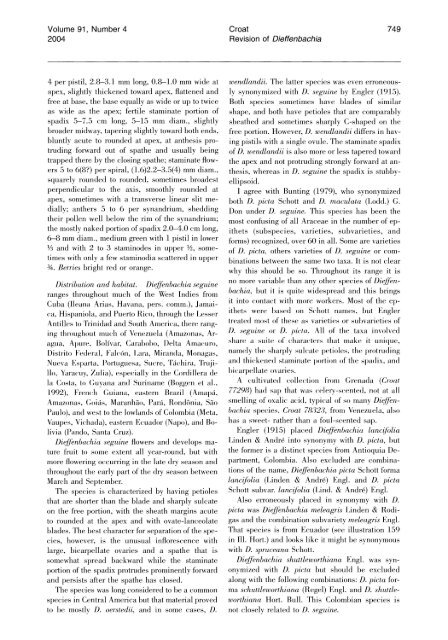l - CNCFlora
l - CNCFlora
l - CNCFlora
Create successful ePaper yourself
Turn your PDF publications into a flip-book with our unique Google optimized e-Paper software.
Volume 91, Number 4<br />
2004<br />
Croat<br />
Revision of Dieffenbachia<br />
4 per pistil, 2.8-3.1 mm long, 0.8-1.0 mm wide at wendlandii. The latter species was even erroneousapex,<br />
slightly thickened toward apex, flattened and ly synonymized with D. seguine by Engler (1915).<br />
free at base, the base equally as wide or up to twice Both species sometimes have blades of similar<br />
as wide as the apex; fertile staminate portion of shape, and both have petioles that are comparably<br />
spadix 5-7.5 cm long, 5-15 mm diam., slightly sheathed and sometimes sharply C-shaped on the<br />
broader midway, tapering slightly toward both ends, free portion. However, D. wendlandii differs in havbluntly<br />
acute to rounded at apex, at anthesis pro- ing pistils with a single ovule. The staminate spadix<br />
truding forward out of spathe and usually being of D. wendlandii is also more or less tapered toward<br />
trapped there by the closing spathe; staminate flow- the apex and not protruding strongly forward at aners<br />
5 to 6(8?) per spiral, (1.6)2.2-3.5(4) mm diam., thesis, whereas in D. seguine the spadix is stubbysquarely<br />
rounded to rounded, sometimes broadest ellipsoid.<br />
perpendicular to the axis, smoothly rounded at I agree with Bunting (1979), who synonymized<br />
apex, sometimes with a transverse linear slit me- both D. picta Schott and D. rrzaculata (Lodd.) G.<br />
dially; anthers 5 to 6 per synandrium, shedding Don under D. seguine. This species has been the<br />
their pollen well below the rim of the synandrium; most confusing of all Araceae in the number of epthe<br />
mostly naked portion of spadix 2.0-4.0 cm long, ithets (subspecies, varieties, subvarieties, and<br />
6-8 mm diam., medium green with 1 pistil in lower forms) recognized, over 60 in all. Some are varieties<br />
1/3 and with 2 to 3 staminodes in upper 1/2, some- of D. picta, others varieties of D. seguine or comtimes<br />
with only a few staminodia scattered in upper binations between the same two taxa. It is not clear<br />
3/4. Berries bright red or orange.<br />
why this should be so. Throughout its range it is<br />
Distribution and habitat. Dieffenbachia seglline<br />
no more variable than any other species of Dieffenranges<br />
throughout much of the West Indies from bachia, but it is quite widespread and this brings<br />
Cuba (Ileana Arias, Havana, pers. comm.), Jamai- it into contac t with more workers. Most of the epc<br />
a, Hispaniola, and Puerto Ric o, through the LeKsKser ithets were l)ased on Schott names, but Engler<br />
AntilleKs to 'I'rinidad and South Amerie a, there rang- treate(l most of these as varieties or sul)varieties of<br />
ing throughout much of Venezuela (Ama%onaKs, Ar- D. .seguine or D. /)icta. All of the taxa involved<br />
agua, A)ure, Bolivar, Caral)obo, I)elta Amae UIo, share a suite of chara(ters that make it unique,<br />
namely the shar^)]y sulcate l)etioles the )rotru(ling<br />
Distrito Fe(Setal, Fal((')n, 1,ta, Miran(0a, Monagaks,<br />
Nueva Esparta, Portuguesa, Su(re, Ta(hila, 'lruji- an(l thickene(l staminate poltion of the sl)a(lix, an(l<br />
llo, Yarae uy, %ulia), eksl)e( ially in the Cordillera de bit arpellate ovaries.<br />
1a CoKsta, to (,uyana and Suriname (Boggen et al., A e ultivate(l e ollectioll from Gl enada (Croat<br />
1992), Frell( h (uiana, eakstern Brazil (Amal)a, 77298) ha(l sap that was; c elely-s( ente(l, not at all<br />
Amazonaks, (Joials, Maranhao, Para, RondoniaS Sao smelling of oxalic aci(l, tyl)ical of so rnany DiefWen-<br />
Paulo), and west to the lowlands of Colombia (Meta, b(lchi(l species. Croat 78X2S, frorll Venezuela, also<br />
Vaupes, Vie hada), eastern Ecuador (lfapo), and Bo- has a sweet- rather than a foul-se ented sap.<br />
livia (Pando, Santa Cruz).<br />
Engler (1915) placed Dieffenbachi(l lanciJolia<br />
DiefWenlv(lchifl seguine flowers and develops ma- Linden & Andre into synonymy with D. picta, I)ut<br />
ture fruit to some extent all year-round, but with the former is a distinct species from Antioquia Demore<br />
flowering occurring in the late dry season and partment, Colombia. Also excluded are combinathroughout<br />
the early part of the dry season between tions of the name, DieJfienbachia picta Schott forma<br />
March and September.<br />
lancifolia (Linden & Andre) Engl. and D. picta<br />
The species is characterized by having petioles Schott subvar. Iancifzolia (Lind. & Andre) Engl.<br />
that are shorter than the blade and sharply sulcate Also erroneously placed in synonymy with D.<br />
on the free portion, with the sheath margins acute picta was Dieffenbachia nieleagris Linden & Rodito<br />
rounded at the apex and with ovate-lanceolate gas and the combination subvariety nieleagris Engl.<br />
blades. The best character for separation of the spe- That species is from Ecuador (see illustration 159<br />
cies, however, is the unusual inflorescence with in Ill. Hort.) and looks like it might be synonymous<br />
large, bicarpellate ovaries and a spathe that is with D. spruceana Schott.<br />
somewhat spread backward while the staminate Dieffenbachia shuttleworthiana Engl. was synportion<br />
of the spadix protrudes prominently forward onymized with D. picta but should be excluded<br />
and persists after the spathe has closed. along with the following combinations: D. picta for-<br />
The species was long considered to be a common ma schuttleworthiana (Regel) Engl. and D. shuttlespecies<br />
in Central America but that material proved worthiana Hort. Bull. This Colombian species is<br />
to be mostly D. oerstedii, and in some cases, D. not closely related to D. seguine.<br />
749

















